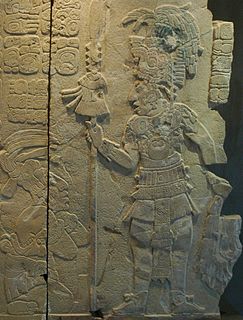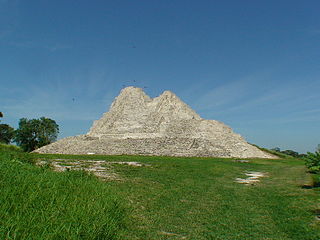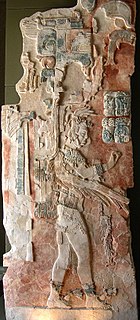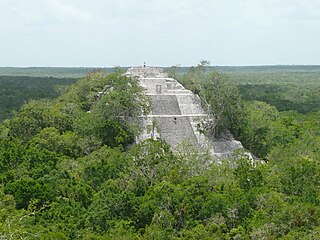
K'inich Janaab Pakal I (Mayan pronunciation: [k’ihniʧ xanaːɓ pakal], also known as Pacal, Pacal the Great, 8 Ahau and Sun Shield, was ajaw of the Maya city-state of Palenque in the Late Classic period of pre-Columbian Mesoamerican chronology. He acceded to the throne in July 615 and ruled until his death. During a reign of 68 years, the longest known regnal period in the history of the Americas, the 30th longest worldwide and longest until Frederick III in the 15th century, Pakal was responsible for the construction or extension of some of Palenque's most notable surviving inscriptions and monumental architecture.
Janahb Pakal also known as Janaab Pakal, Pakal I or Pakal the Elder,, was a nobleman and possible ajaw of the Maya city-state of Palenque.

Sak K'uk' also known as Muwaan Mat, Lady Sak K'uk' and Lady Beastie, was queen of the Maya city-state of Palenque. She acceded to the throne in October, 612 and ruled until 615.

K'inich Kan Bahlam II, also known as Chan Bahlum II, was ajaw of the Maya city-state of Palenque. He acceded to the throne in January, 684, several months after the death of his father and predecessor, K'inich Janaab Pakal I and ruled until his death.

Tonina is a pre-Columbian archaeological site and ruined city of the Maya civilization located in what is now the Mexican state of Chiapas, some 13 km (8.1 mi) east of the town of Ocosingo.

Ajen Yohl Mat also known as Aj Ne' Ohl Mat, Ac Kan and Ahl Lawal Mat, was an ajaw of the Maya city-state of Palenque. He acceded to the throne on January 1, 605 and ruled until his death. He was probably son of Yohl Ik'nal or Sak K'uk' and brother of Janahb Pakal or K'inich Janaab Pakal I. During his reign, his kingdom was invaded on April 4, 611 by Scroll Serpent, ruler of the Kaan kingdom (Calakmul).

K'inich Ahkal Mo' Nahb III also known as Chaacal III and Akul Anab III,, was an ajaw of the Maya city of Palenque. He took the throne on 30 December 721, reigning until c.736.

K'inich K'an Joy Chitam II, also known as Kan Xul II and K'an Hok' Chitam II, October 31, 644 – c.721, was an ajaw of the Maya city of Palenque. He took the throne on May 28, 702 (9.13.10.6.8), reigning until c.721. He succeeded his elder brother K'inich Kan Bahlam II. Their father was K'inich Janaab Pakal I, who had ruled for 68 years, and their mother was Lady Tz'akbu Ajaw. His possible brother could be Tiwol Chan Mat. K'inich K'an Joy Chitam apparently reigned for about nine years. He was captured by the Toniná in 711 and was possibly executed by their leader, K'inich Baaknal Chaak or was later restored to his kingship. He was succeeded in late 721 by K'inich Ahkal Mo' Nahb III.

Itzam K'an Ahk II, also known as Ruler 4, was an ajaw of Piedras Negras, an ancient Maya settlement in Guatemala. He ruled during the Late Classic Period, from 729–757 AD. Itzam K'an Ahk II ascended to the throne following the death of K'inich Yo'nal Ahk II. Itzam K'an Ahk II may have fathered the following three kings of Piedras Negras: Yo'nal Ahk III, Ha' K'in Xook, and K'inich Yat Ahk II. Following Itzam K'an Ahk II's demise, he was succeeded by Yo'nal Ahk III in 757 AD. Itzam K'an Ahk II left behind several monuments, including stelae at Piedras Negras and a large mortuary temple now known as Pyramid O-13. In addition, the details of his life and his K'atun-jubilee were commemorated on Panel 3, raised by K'inich Yat Ahk II several years following Itzam K'an Ahk II's death.
K'an Mo' Hix,, was a nobleman of the Maya city-state of Palenque. He was husband of Sak K'uk', queen of Palenque, and father of K'inich Janaab Pakal I, who was one of the greatest rulers of Palenque and was responsible for the construction or extension of some of Palenque's most notable surviving inscriptions and monumental architecture. He could be a possible father of Ajen Yohl Mat.

Pomona is a Maya archaeological site in the Mexican state of Tabasco, municipality of Tenosique, about 30 miles east of Palenque. Its flowering was in the Late Classic period.

Moral-Reforma is a Maya archaeological site in Mexico, about 70 miles (113 km) northeast of Palenque.
Janaab Pakal III, also known as 6 Cimi Pakal,, was an ajaw of the Maya city of Palenque. He acceded to the throne in November, 799. He was probably last ruler of Palenque and his glyph name comes from blackware vase found in the residential quarter of city.

K'inich K'uk' Bahlam II, also known as Bahlum K'uk' II and Mahk'ina Kuk,, was an ajaw of the Maya city of Palenque. He acceded to the throne on March 4, 764 and ruled until c. 783. He was a son of K'inich Ahkal Mo' Nahb III and Lady Men Nik. Knowledge of him is limited to a few broken monuments: the Tablet of the 96 glyphs, the Creation Tablet, the House B Mural? and Bodega no. 218.

K'inich Kan Bahlam III,, was an ajaw of the Maya city of Palenque. He ruled c.751. Ruler is not mentioned in any monument at Palenque but only one text at Pomona, that suggest his reign was short or troubled.

K'inich Janaab Pakal II, also known as Upakal K'inich,, was an ajaw of the Maya city of Palenque. He ruled c.742 and he was probably brother of K'inich Ahkal Mo' Nahb III. There are only few details about his reign like Bodega no. 1144 and portraits on a stucco-covered pier from Temple 19, only date from his reign is from 742, when he inslalled lord into important office.





















